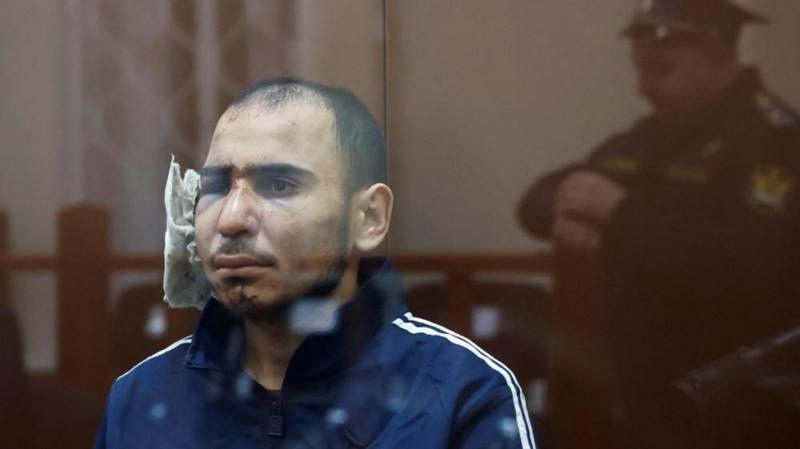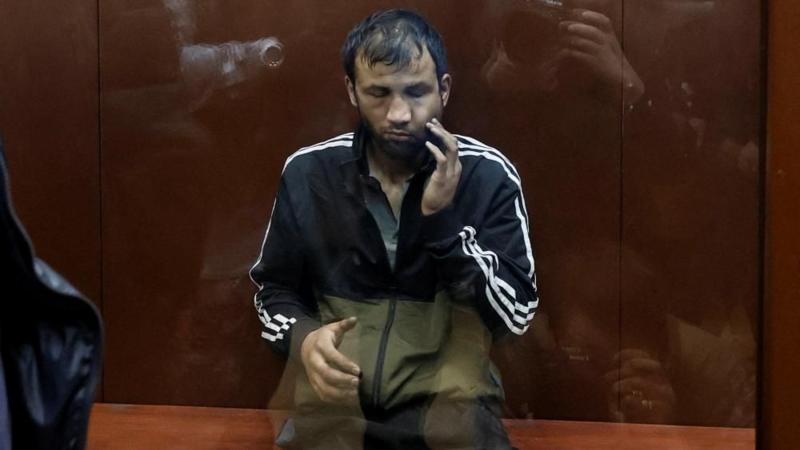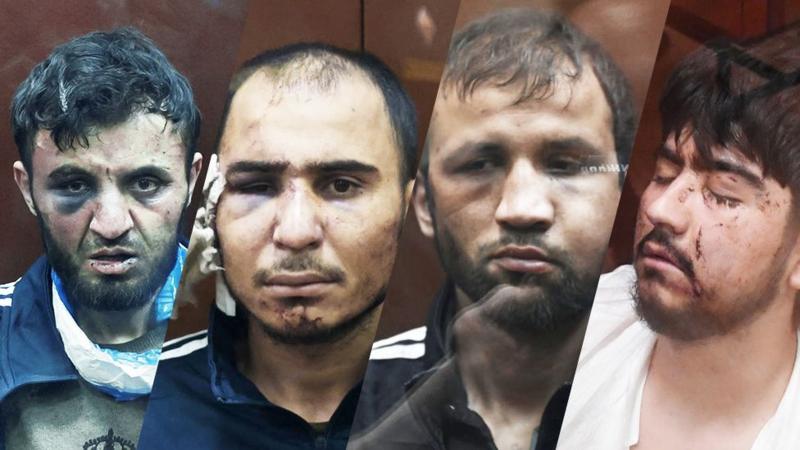Russian media identified four people, who are charged with participation in the deadly terrorist attack on a concert venue in Krasnogorsk on March 22, as Saidakram Rajabalizoda, Dalerjon Mirzoyev, Muhammadsobir Faizov, and Faridoun Shamsiddin and said they are Tajik citizens. The court said three of the four men had pleaded guilty to all charges during the closed-door hearing.
The announcement followed Russian media reports that several Tajik citizens were involved in the deadly attack, while unverified videos purportedly showed several suspects -- Tajik citizens -- being interrogated.
Earlier, the Federal Security Service (FSB) said the 11 suspects arrested in connection with the deadly attack at the Crocus City Hall in Krasnogorsk were foreigners but did not announce their identities.
Radio Liberty’s Tajik Service, known locally as Radio Ozodi, reported on March 25 that the Tajik government insists it has not received any "official information" from Russian authorities about Tajiks allegedly involved in the attack.
Russian lawmaker Aleksandr Khinshtein reportedly wrote on Telegram that Tajik passports were found inside the car the suspects allegedly used to flee before being caught by Russian police in the Bryansk oblast, about 340 kilometers southwest of Moscow.
Radio Ozodi notes that Rajabalizoda, the man who was later charged with terrorism, appeared in two separate, unverified videos that show him confessing to have taken part in the terrorist attack in Krasnogorsk. In graphic footage, Russian security officials are reportedly shown cutting off the man's ear.

According to Vazhnyye Istorii (Important Stories or iStories), which was declared “foreign agent” and “undesirable organization” in Russia, a serviceman, from among supporters of the neo-Nazi organization “Rusich”, cut off Rajabalizoda’s ear.
According to Radio Ozodi, Telegram channels with purported connections to the Russian security agencies published a video purporting to show men cutting off a portion of Rajabalizoda's ear and trying to force him to eat it. The men reportedly also threatened to cut off his genitals.
According to Russia's Fontanka news agency, the video was first published by Telegram channels connected with the notorious Wagner mercenary group.
Speaking Russian with a Tajik accent, the man identified himself as Faridoun Shamsiddin and said he was born in September 1998. He said he had been contacted by the "assistant of an [Islamic] preacher" whose lectures he had been listening to on Telegram.

The assistant reportedly gave no information about himself: “no name, no surname, nor anything else” he claimed.
The face of the Russian-speaking interrogator and other men holding the suspect were not shown in the footage, which was widely circulated on Russian websites and social media on March 23 before appearing on state media outlets.
The authenticity of the video cannot be independently verified, Radio Ozodi notes..
Late on March 24, the Grey Zone Telegram channel, which has also been tied to the Wagner group, reportedly published a photograph purporting to show men torturing suspect Faridoun Shamsiddin. The photograph shows a military radio connected by wire to the suspect's genitals, a well-documented form of torture through electric shock used in the Russian military, according to Radio Ozodi.
Radio Ozodi says locals in a village outside Dushanbe, described Faridoun Shamsiddin as a “coward” and said they were shocked by news their fellow villager was among the suspects in the deadly terrorist attack at the Crocus City Hall near Moscow on March 22.
“I never noticed anything suspicious in his actions. He left for Russia six months ago and has been sending money home to his family,” a relative of Shamsiddin in the village of Loyobi in Hisor district told RFE/RL on March 25.
Speaking on condition of anonymity, the man said Shamsiddin, 25, worked at a local bakery before moving to Russia and “could not have killed a sparrow. He was a coward.”
Married with a son, Shamsiddin was a convicted sex offender and sentenced to seven years in prison for sexual harassment, a relative said. He was granted an early release in 2020.
Asked about Shamsiddin’s religious beliefs, the Loyobi resident said he wasn’t a practicing Muslim: “He never prayed or fasted, and he drank alcohol.”
In Dushanbe, Muhammadsobir Faizov’s mother, Sairam Faizova, said she was “in disbelief” that her 19-year-old son is alleged to have committed such an atrocity.
“He’s not a person who would do something like this. He must have been brainwashed by someone,” Faizova said.
Faizova described her son as nonreligious and someone who “loved going to wedding banquets” and dancing at get-togethers with his friends in Dushanbe.
He even dreamed of studying in China, she added.
Faizov shared Russian songs on his VKontakte social media account and posted photos and videos of himself driving a car and working at the My Style barbershop.
Shamsiddin and other suspects detained and shown in videos made no mention of the IS terrorist group, which claimed responsibility for the mass killings, or the Islamic State-Khorasan offshoot that has also been mentioned as possibly carrying out the attack.
Moscow's Basmanny district court on March 24 remanded the four men -- Saidakram Rajabalizoda, Dalerjon Mirzoyev, Muhammadsobir Faizov, and Faridoun Shamsiddin -- into custody for at least two months pending trial on terrorism charges. The court identified the four as Tajik citizens and said they all admitted guilt after being charged.
The court on March 25 remanded three more suspects, including the former owner of the car that the attackers allegedly used to flee. The suspects are Aminjon, Dilovar, and Isroil Islomov. The court did not explain the relationship between the men, but Aminjon and Dilovar have patronymic names indicating they are sons of Isroil.
Dilovar Islomov is believed to be the last owner of the white Renault used by the attackers. The court ordered the Islomovs to remain in pretrial detention until at least May 22.







